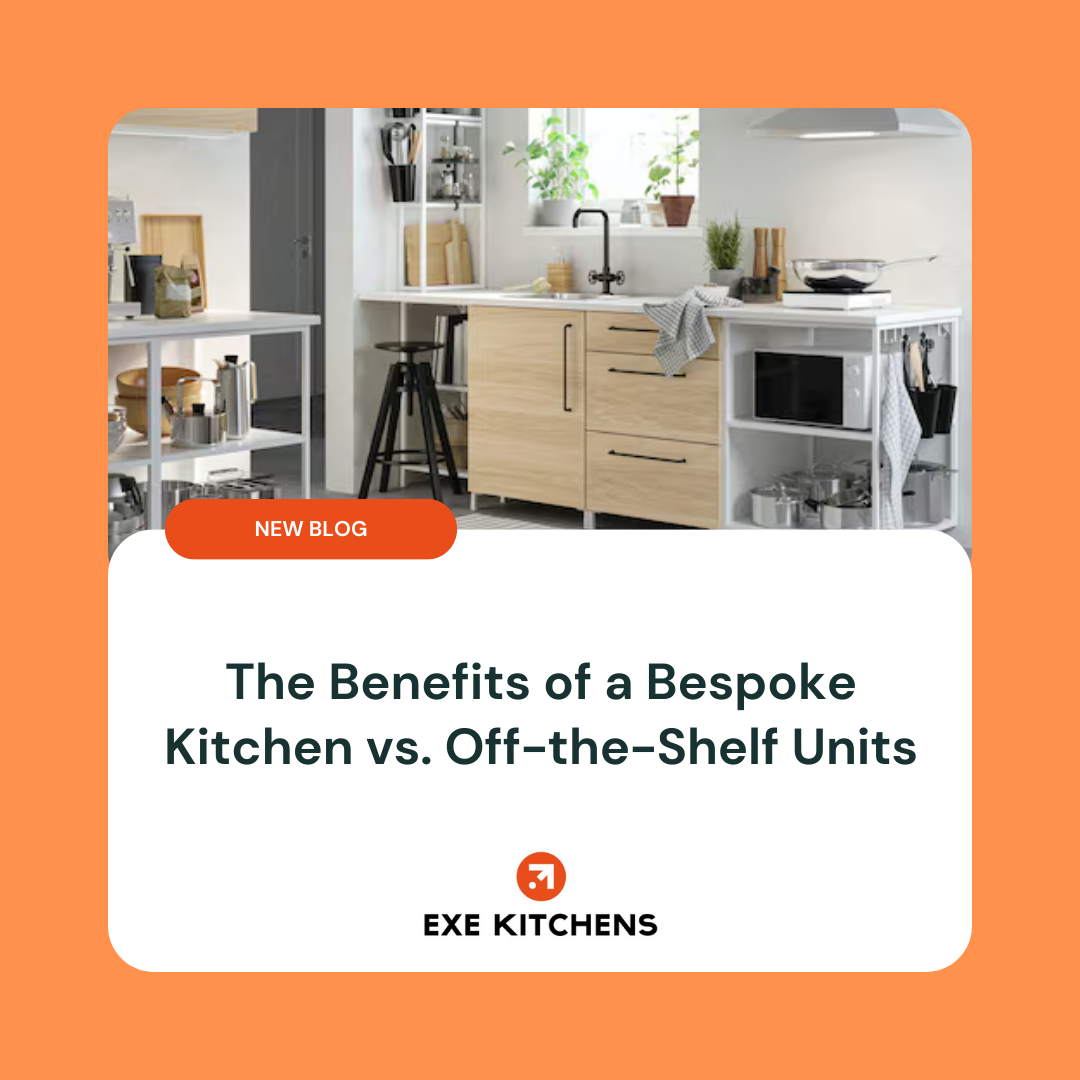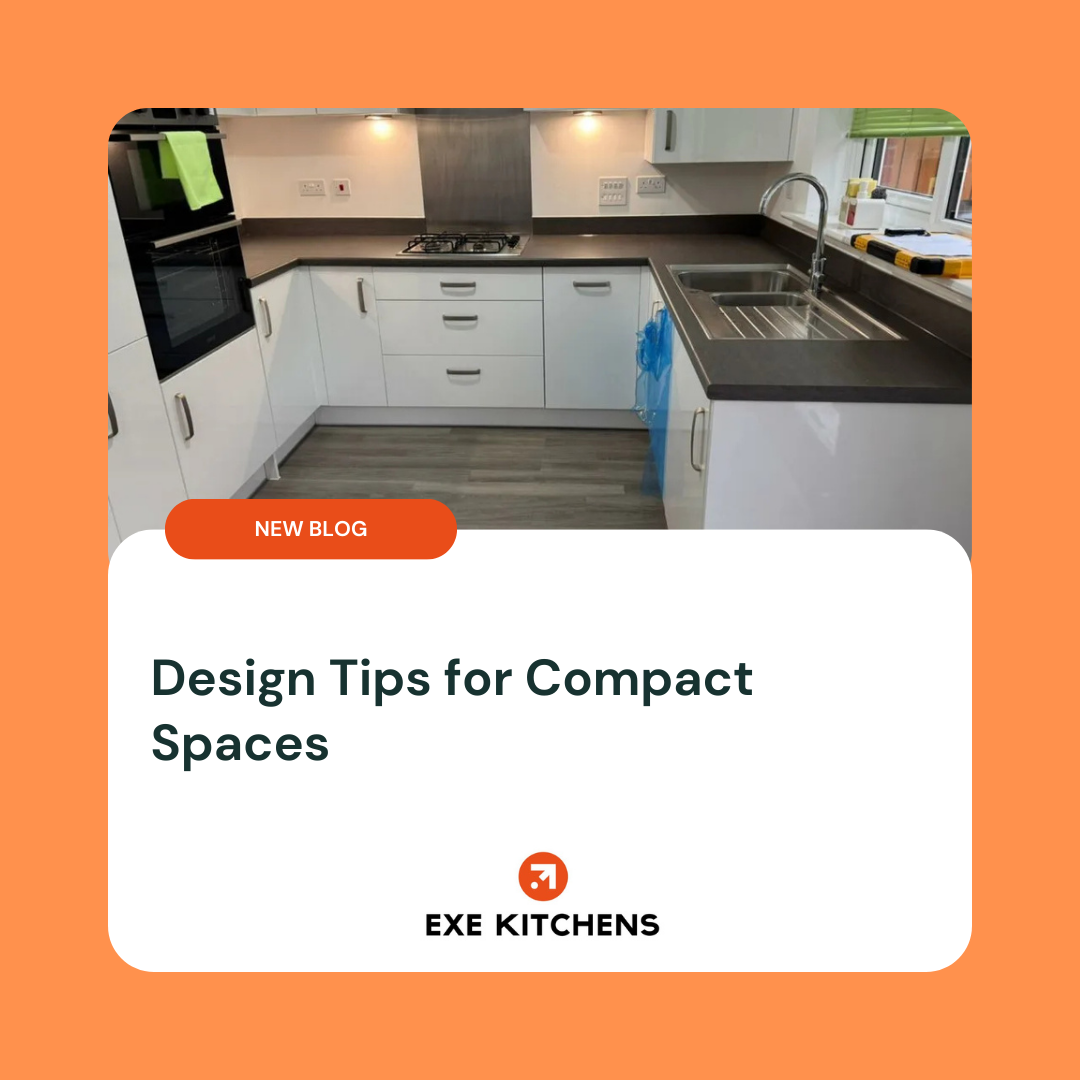Modern Kitchen Design Ideas: Trends and Inspiration for 2024
The kitchen is often referred to as the heart of the home, and in 2024, adopting modern design ideas can truly revitalize this central space. Staying current with these trends not only enhances the functionality but also brings a fresh aesthetic that impresses both daily occupants and dinner guests.
Our deep dive into this year’s top trends reveals innovative styles such as Scandinavian simplicity, edgy Industrial finishes, and sophisticated Mid-Century Modern elements. These carefully researched trends seamlessly combine beauty and practicality, ensuring your kitchen remains both stylish and highly functional.
Some modern kitchen design ideas include incorporating open floor plans to enhance space, utilizing minimalist cabinetry with sleek lines, and integrating smart appliances for added functionality. Additionally, using materials such as quartz countertops and mixed metals can elevate the aesthetic while maintaining a cohesive look.
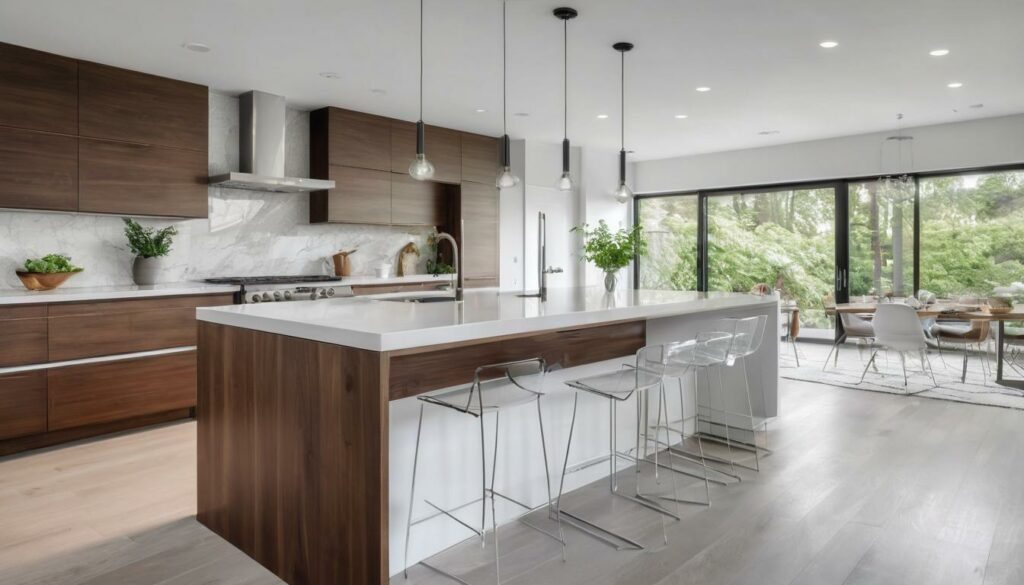
Exploring Modern Kitchen Design Styles
Scandinavian Style
The essence of Scandinavian kitchen design lies in its commitment to simplicity and functionality. This style embraces light and space, creating an inviting atmosphere that feels fresh and airy. Imagine entering a kitchen where soft, neutral colors dominate, complemented by natural light filtering through large windows.
The cabinetry often appears seamless, with simple hardware required for a minimalist feel. The use of light wood finishes, such as birch or ash, adds warmth and a connection to nature that is characteristic of this design philosophy.
A classic combination might be white cabinetry paired with oak countertops, enhancing the clean lines while still providing a touch of organic sophistication. The emphasis here is not just on aesthetics but also on practicality; every feature should serve a purpose while looking good.
Industrial Style
Now let’s shift gears to the industrial kitchen aesthetic, which celebrates raw materials and urban elements. Imagine a space filled with exposed brick walls and metal piping that tells a story of transformation from an industrial workspace to a dynamic home environment. This style invites boldness through concrete countertops crafted with artisan techniques, giving the impression of durability along with style.
An integral part of the industrial look is open shelving; it allows for both functional storage and creative displays. Displaying sleek stainless steel appliances further accentuates this edgy atmosphere while maintaining high functionality. To balance the raw materials, consider incorporating warm lighting – think vintage bulbs dangling from metal fixtures – to soften the overall ambiance.
Mid-Century Modern Style
Finally, we venture into the mid-century modern kitchen style that originated in the mid-20th century. This design emphasizes organic shapes and embodies simplicity while cleverly integrating high functionality. Picture smooth wooden finishes like walnut cabinets that capture your attention with their rich tones and distinct grain patterns.
This style often utilizes geometric forms that bring an artistic flair to even the most utilitarian aspects of kitchen design. Adding pops of color can breathe life into this aesthetic; vibrant hues like teal or mustard pair beautifully against more muted backgrounds.
Materials should feel rich yet accessible, merging comfort with elegance. It’s about creating a space where you can cook, share meals, and make lasting memories—without sacrificing on either form or function.
Armed with insights into these distinctive styles—from Scandinavian to Industrial and Mid-Century Modern—you are now poised to explore the nuances of designs that emphasize clean lines and understated elegance.
Sleek and Minimalist Trends
Minimalism in kitchen design emphasizes clutter-free spaces while showcasing pure forms and functional elements. This clean aesthetic reflects a deeper desire for tranquility within our over-stimulating lives. As revealed in a 2023 interior design survey, 68% of homeowners now prefer minimalistic kitchens for ease of maintenance, indicating many are seeking this serene environment.
Central to modern minimalist kitchens are handleless cabinets and integrated appliances. These elements contribute to a seamless look that enhances the perception of space. For example, imagine cabinets equipped with push-to-open mechanisms and drawers that have no visible handles. It creates a smooth surface that invites you to interact without distractions. This focus on simplicity can transform the often chaotic cooking environment into a peaceful retreat.
When embracing this style, consider opting for built-in appliances like ovens, dishwashers, and refrigerators that blend seamlessly with the cabinetry. Integrating these appliances enhances the sleek look while maximizing space efficiency—everything is tucked away, leaving surfaces free from visual noise.
Similarly, the choice of materials plays a critical role in achieving this minimalist aesthetic. High-gloss finishes or matte textures lend an elegant touch while providing easy cleaning options. Using materials such as quartz or natural stone for countertops promotes durability without compromising style. For flooring, selecting large-format tiles reduces grout lines, creating an uninterrupted visual flow.
It’s important to remember that minimalism is not just about aesthetics—it extends to organization and storage as well, laying the groundwork for understanding the latest advancements in countertop options.
Innovative Countertop Materials
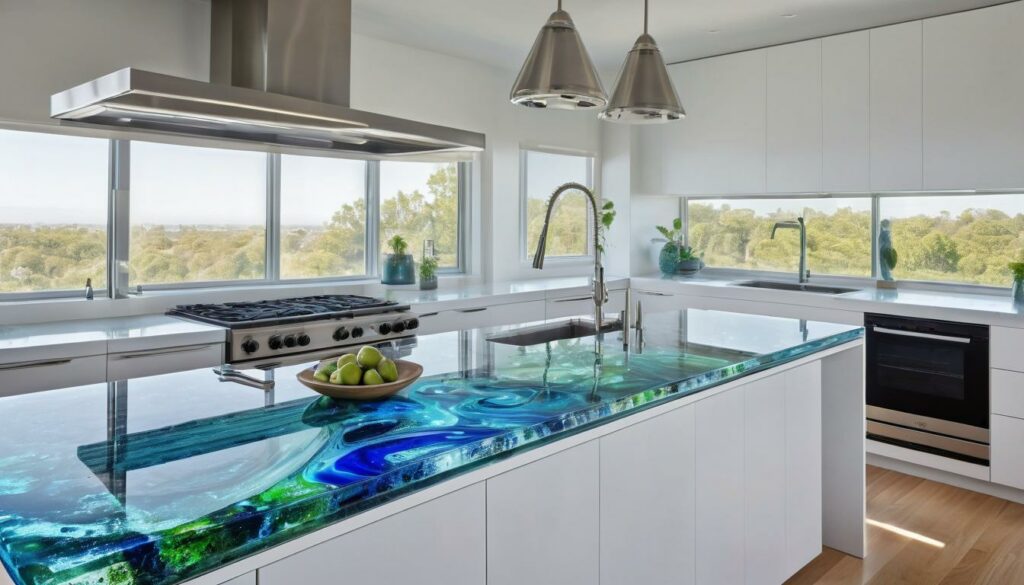
Countertops truly define the overall character of a kitchen; they act as the visual anchor in that space. One remarkable material emerging as a strong contender is quartz composite. This engineered stone combines natural quartz with resins, resulting in a surface that excels in durability while offering an array of colors and patterns. For those seeking something that not only looks remarkable but also resists stains, scratches, and heat, quartz composite is hard to beat.
Leading brands like Caesarstone and Cambria have built their reputations on delivering high-quality products that emulate the beauty of natural stone while providing superior performance.
While quartz composite delivers excellent functionality, another increasingly popular material deserves attention: recycled glass.
Recycled Glass
Embracing sustainability in design, recycled glass countertops bring both ecological awareness and visual interest to modern kitchens. These countertops are crafted from post-consumer glass mixed with resin, producing stunning surfaces reminiscent of unique mosaics.
The variety of colors—from clear to vibrant hues—allows homeowners to express their style while contributing to environmental preservation.
“Eco-friendly and visually distinctive, recycled glass countertops are our go-to for clients aiming for sustainable luxury,” shares a prominent interior designer.
Here’s where the charm lies: not only do these countertops look distinctively beautiful, but they also tell a story about conscientious living.
When considering materials for your kitchen, keep in mind that both quartz composites and recycled glass achieve a balance between aesthetics and practicality. Yet as you think over these options, consider how they resonate with your design ethos and lifestyle. Are you more inclined towards something ultra-modern with clean lines? Or do you dream of incorporating splashes of color through eco-friendly selections?
As you reflect on your priorities and preferences, innovative materials can transform the ordinary into extraordinary – making your kitchen a centerpiece that embodies both functionality and flair. This exploration leads naturally to examining the latest advancements in kitchen technology designed to enhance your culinary experience.
Cutting-Edge Kitchen Appliances
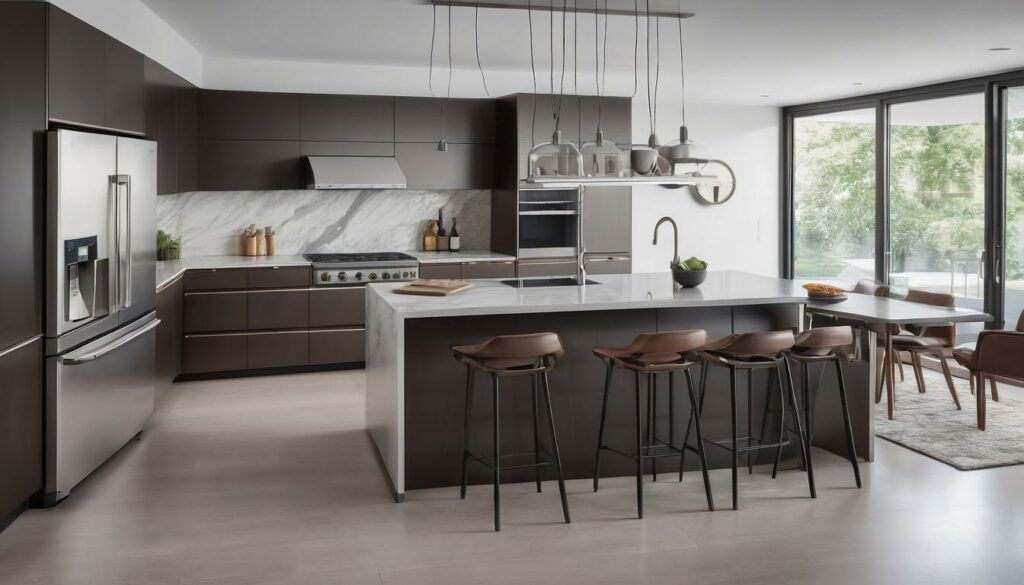
Appliances truly play a pivotal role in the effectiveness and efficiency of our culinary spaces, acting as both tools and design elements. Modern kitchen appliances integrate advanced technology, catering to today’s busy lifestyles while also looking great.
Smart Refrigerators
Smart refrigerators are leading this revolution by offering far more than just cold storage. These appliances come packed with touchscreen interfaces that allow you to manage grocery lists right from your fridge’s door. Equipped with cameras, they let you peek inside from your smartphone while you’re at the store, ensuring you never forget an item again. The grocery tracking feature can even alert you when items are running low, making meal planning and shopping effortless.
Imagine getting ready to cook and simply swiping on your fridge display to inspire a dinner recipe based on what you have available. That’s a real game changer.
Induction Cooktops
In terms of cooking, induction cooktops represent a fascinating shift toward energy-efficient techniques. Unlike traditional gas stoves, induction technology generates heat directly in the cookware itself, allowing for greater control over temperatures and faster cooking times. This means less waiting for water to boil or worrying about uneven heat distribution. Additionally, many brands like Bosch and Samsung have designed their models to include sleek, touch-sensitive controls that blend seamlessly into modern aesthetics, enhancing both safety and usability for the chef at home.
Cooking becomes not just simpler but also safer; the cooktop surface remains cool to the touch, minimizing risks if little ones are underfoot.
Steam Ovens
Steam ovens have gained popularity among health-conscious individuals who understand the value of nutrition in cooking. By injecting steam into the cooking cavity, these ovens maintain food’s nutrients and moisture levels, preserving flavor and texture. It’s particularly ideal for vegetables which often lose their vibrant colors and essential vitamins when boiled or roasted without careful monitoring. Incorporating a steam oven into your kitchen is not only about preparing food but also about nurturing healthful eating practices without sacrificing taste.
Picture a perfectly cooked piece of salmon that’s moist on the inside yet beautifully flaky—this is achievable with steam ovens!
As we explore these innovative appliance options, it becomes essential to focus on how lighting can further enhance both functionality and aesthetics in our modern kitchens.
Lighting Solutions for Modern Kitchens
Lighting plays a pivotal role in setting the tone and functionality of a modern kitchen. It not only helps you see what you’re doing but also enhances the beauty and efficiency of the space. Imagine entering your kitchen first thing in the morning; soft ambient light greets you, making everything feel warm and welcoming. In stark contrast, trying to prepare dinner under harsh overhead lighting can be less than ideal! Finding the right balance of lighting solutions will transform your kitchen into a functional yet inviting environment.
Task Lighting
One of the most essential forms of lighting in any kitchen is task lighting. This ensures that specific work areas are well-lit, improving safety and efficiency while cooking or preparing meals.
For instance, under-cabinet lights are invaluable as they illuminate counter spaces where tasks like chopping vegetables or mixing ingredients take place. This type of lighting brightens dark corners and reduces shadows that can complicate food preparation. Opting for LED strip lights or puck lights offers adjustable brightness levels, allowing you to tailor the intensity based on the task at hand.
Moving beyond areas where work is performed, it’s vital to create a cozy and relaxing atmosphere where family and friends can gather.
Ambient Lighting
Ambient lighting ties everything together in a modern kitchen. It creates comfortable overall illumination that fills the entire space without being overwhelming.
Recessed ceiling lights contribute significantly by providing general light while maintaining a clean aesthetic. You might consider installing LED strips along the edges of shelves or countertops—these serve dual purposes: enhancing architectural features while casting soft illumination throughout the space. A well-designed ambient lighting scheme promotes relaxation, making your kitchen multifunctional—a place not only for cooking but also for enjoying meals, socializing, and unwinding after a long day.
While both task and ambient lighting are crucial, don’t overlook features that add character to your space.
Pendant Lighting
Pendant lights over kitchen islands have become iconic elements of modern kitchens, serving both practical and stylistic purposes. These fixtures offer significant visual interest to the room while providing functionality.
When selecting pendant lights, it’s important to choose designs that align with your kitchen’s overall aesthetic—whether sleek and minimalistic or bold and eclectic. A thoughtful choice here complements the color scheme and decor style while providing focused illumination exactly where you need it most. Imagine pendant lights with warm-toned bulbs hanging above the island, creating an inviting focal point perfect for casual dining or entertaining guests.
Together, these various types of lighting solutions can greatly enhance your kitchen’s usability and appeal, leading naturally into discussions about maximizing space with innovative storage solutions.
Smart Storage Ideas
Creative storage solutions can truly transform not just the functionality of your kitchen but also the overall feel of the space. Consider incorporating pull-out pantries, especially in compact kitchens where every inch counts. These allow you to maximize access to all ingredients without having to dig into deep cabinets. Imagine pulling out a sleek pantry filled with neatly organized cans and spices right at arm’s reach while cooking—a game changer!
- Pull-out pantries: The beauty of pull-out features lies in their ability to provide easy access to a variety of items without requiring large amounts of space.
- Lazy Susan corners: Corner cabinets have long posed a challenge for accessing pots and pans stacked out of sight. A lazy Susan can spin these items around, giving you access to everything in that cabinet with just a simple turn.
- Magnetic knife strips: Not only do these save valuable counter space, but they also keep your knives within reach, making meal preparation feel seamless and efficient.
Beyond the essentials, think about hidden drawers within existing drawers; these clever compartments can help you store utensils or small kitchen gadgets, providing an organized approach to minimalism on your countertops. It’s amazing how a few hidden spots can alleviate visual clutter and create a sense of calm.
An organized kitchen is a happier one—clutter usually breeds stress, especially when meals are being prepared during busy times.
To expand on this principle, let’s consider the broader implications of storage solutions. What often gets overlooked is vertical space.
Utilizing Vertical Space
In many kitchens, the walls offer valuable real estate that goes unused. Installing shelves or hanging racks can enhance both storage and decoration at once. Picture open shelves lined with beautifully arranged dishes or herbs in decorative pots organically blending form and function—it’s an excellent way to showcase your personality while keeping items handy.
- Wall-mounted racks: These can hold pots, pans, or even utensils, leaving more counter space for food prep.
- Vertical dividers: Perfect for storing baking sheets upright, so they’re easy to pull out when needed while reducing wear from stacking.
- Over-the-door organizers: A chic option for those with smaller kitchens—utilizing the back of cabinet doors for spices or cutting boards can save lots of room.
Embracing smart storage ideas will not only make your kitchen neater but also improve your cooking experience by allowing for efficiency and ease of access to what you need when you need it. This thoughtful arrangement creates a harmonious environment that invites culinary creativity and enjoyment.
As we explore further into design elements, another important aspect to consider is how color plays a vital role in shaping the ambiance and mood of your kitchen.
Color Palettes of 2024
Color sets the mood of the kitchen, and 2024 introduces a range of sophisticated palettes that elevate both aesthetics and functionality. One of the most notable trends this year is the growing popularity of earth tones that reconnect us with nature. Colors like terracotta, sage green, and sandy beige have seen a significant uptick, registering a remarkable 42% rise according to leading interior design analyses. These warm, inviting shades bring a sense of calmness into your cooking space, reminiscent of natural landscapes. They meld effortlessly with wooden finishes and stone textures, creating an environment where one can feel at home.
Earth Tones
Picture sipping your morning coffee surrounded by soft earth tones; they wrap your kitchen in comfort and warmth. But it’s not just about comfort—these colors are practical too. Earthy shades tend to hide small stains or wear better than lighter hues, making them suitable for high-traffic areas in the kitchen. Incorporating these tones isn’t limited to walls or cabinetry; consider using them in your choice of dishware or small appliances to create continuity throughout the room.
Yet, if you’re looking to inject energy into your kitchen without committing to full earth tones, bold accents can provide that vibrancy.
Bold Accents
Bold splashes of navy blue or forest green can act as dramatic accents on an island or feature wall, immediately drawing the eye without overwhelming the space. This combination allows homeowners to express individuality while still maintaining a cohesive design. For example, imagine a deep navy island paired with creamy white cabinets; it creates stunning contrast while still feeling inviting. When choosing bold colors, consider incorporating them through smaller elements such as bar stools or decorative items instead of painting entire walls to maintain balance and avoid visual clutter.
Remember that a well-planned accent can turn an ordinary area into a focal point filled with character and charm.
Alongside these lively options, there’s a trend toward timeless elegance through monochrome schemes that remain ever-popular among homeowners seeking simplicity.
Monochrome
Monochrome kitchens utilizing shades of white, grey, or black deliver a sense of understated elegance that never goes out of style. These color schemes encourage minimalism while allowing for versatility in design. You might visualize a sleek black-and-white combination; it delivers sophistication while making smaller spaces feel larger. The key is in the textures—smooth surfaces juxtaposed with matte finishes in different shades can add depth without relying on color alone.
Furthermore, monochromatic designs allow for easy adaptation as trends evolve over time—instead of repainting an entire kitchen when new colors come into vogue, simply update accessories or add patterned textiles for freshness while retaining your core palette.
As we explore ideas that promote openness and flow within home environments, you’ll discover how seamless layouts enhance both functionality and aesthetic appeal.
Open-Concept Kitchen Inspirations
Open-concept kitchens are at the heart of modern living spaces—they create a dynamic flow between cooking, dining, and lounging areas. This seamless blend enhances social interaction, transforming day-to-day routines into shared experiences. Imagine preparing a meal while engaging in conversation with family or friends seated nearby. The beauty of an open-concept design is that it invites connection, making everyone feel involved, whether they’re chopping vegetables or simply enjoying a glass of wine while waiting for dinner.
Integrated Living Spaces
At the core of these designs are kitchen islands, which serve as versatile hubs in any kitchen. Not merely a space for food prep, these islands double as dining areas—perfect for casual meals or quick breakfasts before the day begins. They can also provide additional storage for pots, pans, and utensils, maximizing your kitchen’s functionality. Think of this feature as both an anchoring point and a social hub where everyone gathers naturally.
But to create this inviting atmosphere, you must consider how one area flows into another.
Seamless Transitions
To achieve cohesion across an open floor plan, consistent flooring materials and color schemes are essential. Selecting a single type of flooring—like hardwood or high-quality tile—to cover both the kitchen and adjoining spaces fosters visual unity that seamlessly ties everything together. For instance, if your kitchen features warm oak cabinetry, extending those hues throughout the living area with similar tones helps maintain harmony even in larger spaces.
Likewise, consider furniture selections carefully; picking bar stools that match your dining chairs can unify both spaces. When furniture pieces share complementary designs or colors, they not only enhance the aesthetic appeal but also promote a smooth circulation from one area to the next.
| Element | Benefits |
|---|---|
| Kitchen Island | Multi-functional workspace |
| Consistent Flooring | Visual unity across areas |
| Coordinated Furniture | Aesthetic harmony for seamless flow |
If you find your open-concept layout feels too exposed at times, consider incorporating sliding doors or room partitions. These options let you separate the kitchen from the living area when desired while still allowing for openness when fostering interaction.
By embracing integrated living and seamless transitions, an open-concept kitchen dramatically enhances not only your space but also daily interactions within your home.
In designing your modern kitchen for 2024, utilizing open concepts not only maximizes space but creates a welcoming environment for gatherings and daily life alike.

